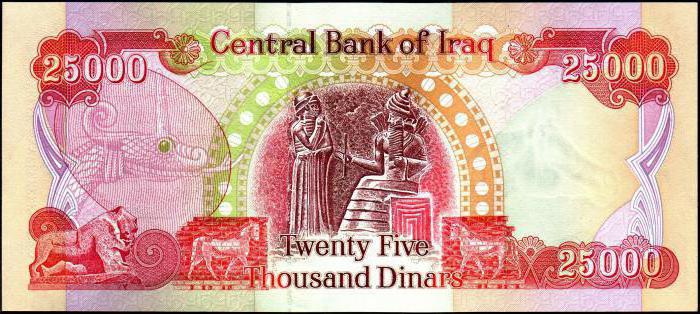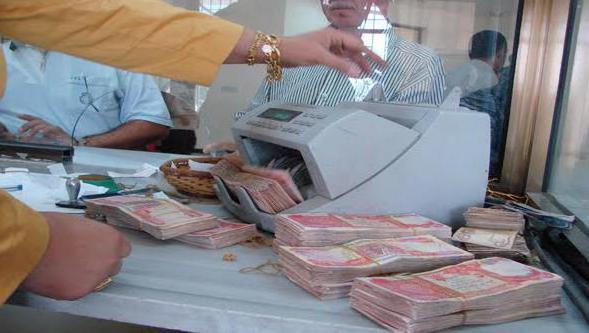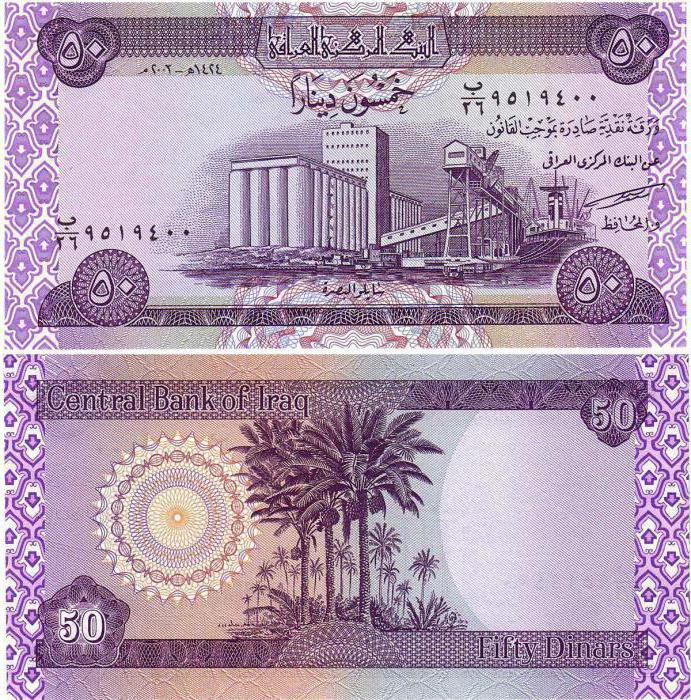Iraq, like all countries, has its own currency. The national currency is called the dinar. Its name comes from the Roman currency. It was called a denarius. Filza was put into circulation as a small bargaining chip in Iraq. 1000 units are equal to one dinar. But fils are practically not used in the country.
Currency history
Iraq has long been part of the Ottoman Empire. Its official currency was piastre, and the most popular coin in everyday life was the Indian rupee. In 1916, British troops separated the modern territories of Iraq from the Ottoman Empire. The national currency was declared the Indian rupee, and the piastre was completely withdrawn from circulation.
The Iraqi dinar was released and put into use only in 1931-1932. It became the national currency, replacing the Indian rupee. Until 1959, the dinar was equal to the British pound. Then, the Iraqi dinar rate was calculated in US dollars in a ratio of 1: 2.8.
The era of Saddam
From 1986 to 2003 in circulation it was often possible to meet dinars with a portrait of Saddam Hussein. After the Gulf War, they found themselves in constant circulation. Initially, the Iraqi dinar did not differ in stability. After the collapse of the banking system, hyperinflation began. Gradually, the currency of Iraq became one of the most stable in the world market.
In 1990, one dinar was equal to three US dollars. Due to inflation, fils were not at all welcomed in everyday life, but nevertheless they were sometimes taken into account in the calculations. Exchange offices in Iraq were practically absent. Most often, you could get another currency only at banks or hotels. By 2003, the dinar rate plummeted. To obtain one American dollar, 2,000 Saddam dinars were required.
At this time, in the north of the country, the old currency was still walking (without the image of Hussein). This money was called Swiss, as it was assumed that they were printed in this country. The old currency was the main one in Kurdistan.
Post-Saddam time
July 8, 2003, another monetary reform was carried out in Iraq and the Central Bank was created. The interim administration of the country planned not only to replace all the old currency with a new one, but also to create money of a single sample. As a result, it was decided to bring back the Iraqi dinar, which was withdrawn from circulation in 1991. The color of banknotes and their denomination were changed in the new currency. Saddam dinars were completely taken out of use in 2003. These banknotes were burned in special furnaces. Iraq switched to the new currency on October 15, 2003.
Banknotes of Iraq
As soon as Iraq gained independence, its currency changed repeatedly. And interestingly printed inscriptions and denominations. The advantages of banknotes on the front side were displayed in Arabic, and on the back - in English. The inscriptions were always printed simultaneously in both languages. New denominations had face values (in dinars):
- 50;
- 250;
- 1000;
- 5000;
- 10000;
- 25000.
The exchange of old bills for new ones continued until the beginning of 2004. After that, banknotes with the image of Hussein became invalid. After the exchange in Baghdad, one US dollar was equal to 1000 dinars. In January 2004, the Iraqi dinar to ruble exchange rate was 0.018994: 1.
The main colors of the new banknotes were ocher, red-brown and purple. An image of the Central Bank is printed on the back of the bills. Dinar is protected from fakes with:
- embossed letters;
- security threads;
- watermarks;
- security characters that change color depending on the inclination of the bill.
A metallized diving strip that appears on the front of the banknote is soldered to the Iraqi dinar. To the right of the center of the bill runs another strip along its entire length, with engraved Arabic text.
Coins of Iraq
Iraqi coins appeared in circulation from 1931-1932. They were issued by virtues (in fils):
- 1;
- 2;
- 4;
- 10;
- 20;
- 50;
- 200.
The last three denominations were made of silver. In 1953, coins appeared in denominations of 100 fils. They were also made of silver. In 1959, coins were put into circulation with the advantages (in fils):
- 5;
- 10;
- 25;
- 50;
- 100.
Since 1967, a coin in 1 fils has disappeared from use. Since 1970, the release of money from nickel in denominations of 250 units began. A year later, coins appeared in 500 fils. Since 1980, coins with a face value of 1 dinar appeared in circulation. In 1990, due to the depreciation of this currency, the production of fils stopped. New coins appeared only in 2004. They were minted in denominations: 25, 50 and 100.
Currency exchange
The Iraqi dinar to the dollar is quite volatile. Therefore, the currencies of other countries (mainly neighboring) are in free circulation on the territory of Iraq. Some hotels charge only foreign currency for the offered services (most often euros or dollars). Banks for exchanges are open from Saturday to Thursday, in the morning. In Ramadan, they close at 10:00.
The financial and banking systems are now under reconstruction, as they were almost completely destroyed under Hussein. Therefore, most often, currency exchange takes place in special shops or in markets. It is interesting that street money changers conduct honest business, and there are no frauds in their activities.
There is another feature of the exchange. For example, at the moment, the Iraqi dinar to the ruble is 1: 0.04914. But at the same time, the real exchange rate in the country's exchangers may vary. In Iraq, the mark-up will depend on the particular bank in which the operation is performed.